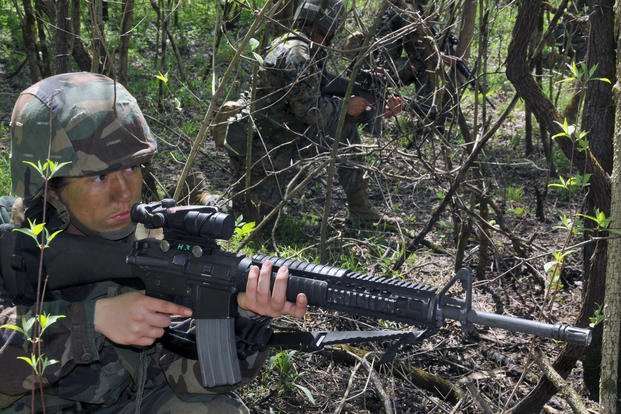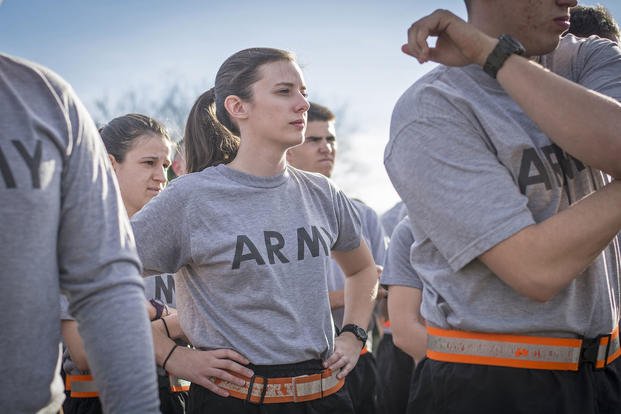Each branch of service has similar requirements in its fitness testing. However, there are some differences between the test required for gaining entrance into the service academies or any branch of ROTC scholarship. In some cases, the test you must take to get to these four-year opportunities of college scholarships for military service is completely different from the fitness test you will take as a cadet or midshipman.
Regardless, one thing holds true. These college scholarships are highly competitive, and there are many variables upon which students will be judged. You will be competing against other students in the following categories:
- Academic achievement
- Test scores (ACT/SAT)
- Athletics
- Leadership roles (teams, clubs, school government)
- Physical fitness test
- Interview
Don't Overlook the Physical Mission of Military Service
Being physically prepared often is overlooked by many applicants. Being an athlete in high school may not prepare you adequately for the requirements of military fitness. For instance, if you are a running athlete, you may have upper-body strength weaknesses. If you are a power athlete, you may think running long distances is anything more than 100 yards. Understanding your weaknesses when it comes to military fitness is crucial to your performance on these competitive fitness tests.
First, you must practice taking the test a few times before taking it officially. Being physically incapable of handling your first several weeks of training, whether at a service academy or an ROTC unit, could prevent you from completing the course or receiving a fully paid scholarship within your ROTC unit.
Here is a breakdown of the fitness tests the various branches of service use for their entry into the military, as well as the fitness test you will take every six months once you are accepted into a program.

Service Academies
The U.S. Military Academy (West Point), Naval Academy, Air Force Academy and Merchant Marine Academy use the candidate fitness assessment (CFA), which includes:
- A kneeling basketball throw*
- Cadence pull-ups
- 120-foot shuttle run (30 feet x 4)
- Crunches for two minutes
- Push-ups for two minutes
- One-mile run
*Many people ask, "Why do we have to throw a basketball for a fitness test?" Good question. I asked one of the people who created this test (Professor Ed Perry), who was a wrestling coach and professor at the Naval Academy for more than 40 years, and he simply stated, "It measures athletic potential." You do not argue with Coach Perry.
Coast Guard Academy
The Coast Guard Academy does not use the CFA; it uses the Physical Fitness Examination (PFE), which is a push-up test to cadence (until you fail), a plank test and a 1.5-mile run.
Army ROTC
Be prepared to take the full Army physical fitness test (APFT) -- push-ups for two minutes, sit-ups for two minutes and a two-mile run. The applicant fitness assessment has students only running a one-mile test (prior to scholarship acceptance), but to keep your scholarship, you must perform within standards of the regular APFT.
Air Force ROTC
You will take the same fitness test as you will take in the Air Force ROTC unit. The regular Air Force physical fitness test is one minute of push-ups, one minute of crunches and a 1.5-mile timed run.

Navy ROTC
The applicant fitness assessment (AFA) has students only running a one-mile test, but still doing two-minute push-up and sit-up tests (prior to scholarship acceptance). To keep your scholarship, though, you must perform within standards of the regular PFT. The regular Navy fitness test consists of two minutes of push-ups, two minutes of sit-ups and a 1.5-mile timed run.
USMC Option
Typically, you will be accepted into a Navy ROTC unit with the USMC option at graduation, but you will spend your summer training with Marine Corp training programs such as Officer Candidate School (six-week courses). Therefore, you must meet the USMC fitness test standards. The USMC test consists of pull-ups -- max (or flexed arm hang for women); crunches for two minutes; and a three-mile run, so be prepared for this test. Also, see Patrol Leaders Course for other tuition options.
General statement on competitive scores: You can maximize these fitness tests, which will put you in good stead with the scholarship selection board. However, they are looking at the whole person -- not just academics and not just athletic abilities, but everything, as mentioned above. If you want to perform at a competitive level on any of these tests, score the following numbers:
Men
- Push-ups one minute: 50
- Sit-ups one minute: 50-60
- Pull-ups 10+
- Push-ups two minutes: 80-100
- Sit-ups two minutes: 80+
- One-mile run: Six minutes
- 1.5 mile run: Nine minutes
- Two-mile run: 12 minutes
- Three-mile run: 18-19 minutes.
- 120-foot shuttle run: Sub-eight seconds
Women
- Push-ups one minute: 30-40
- Sit-ups one minute: 50
- Pull-ups 5 (or flexed arm hang: one minute)
- Push-ups two minutes 40-50
- Sit-ups 2 minutes: 80+
- One-mile run: Seven minutes
- 1.5-mile run: Sub-11 minutes
- Two-mile run: 14-15 minutes
- Three-mile run: Sub 21-22 minutes
- 120-foot shuttle run: Sub-nine seconds
Final notes: With the basketball toss, if you can get over 70 feet for a male and over 50 feet for a female, you are in above average. Sit-ups and crunches are different exercises. Sit-ups are harder and require more practice. Work on your pace for either exercise. Proper Sit-ups.
P.S.: Do not strive for the minimum standard in anything. That is not a goal you should set for yourself. That would be equivalent to getting a D in math class. Take the physical mission seriously; it could save your scholarship one day or, more importantly, your life.
If you think these competitive scores are too tough, do not get discouraged. Still apply if you want to serve. People get accepted with lesser scores than listed in this article. However, do yourself a favor and get on a program and practice these tests. Ideas: PFT Bible or CFA/PFT Prep.
Other resources:
- The Insider's Guide to Army ROTC Scholarships by Col. Robert Kirkland
- The PrepWellAcademy.com: an online mentoring program for college prep/scholarship resources..
Stew Smith is a former Navy SEAL and fitness author certified as a Strength and Conditioning Specialist (CSCS) with the National Strength and Conditioning Association. Visit his Fitness eBook store if you're looking to start a workout program to create a healthy lifestyle. Send your fitness questions to stew@stewsmith.com.
Want to Learn More About Military Life?
Whether you're thinking of joining the military, looking for fitness and basic training tips, or keeping up with military life and benefits, Military.com has you covered. Subscribe to Military.com to have military news, updates and resources delivered directly to your inbox.



















